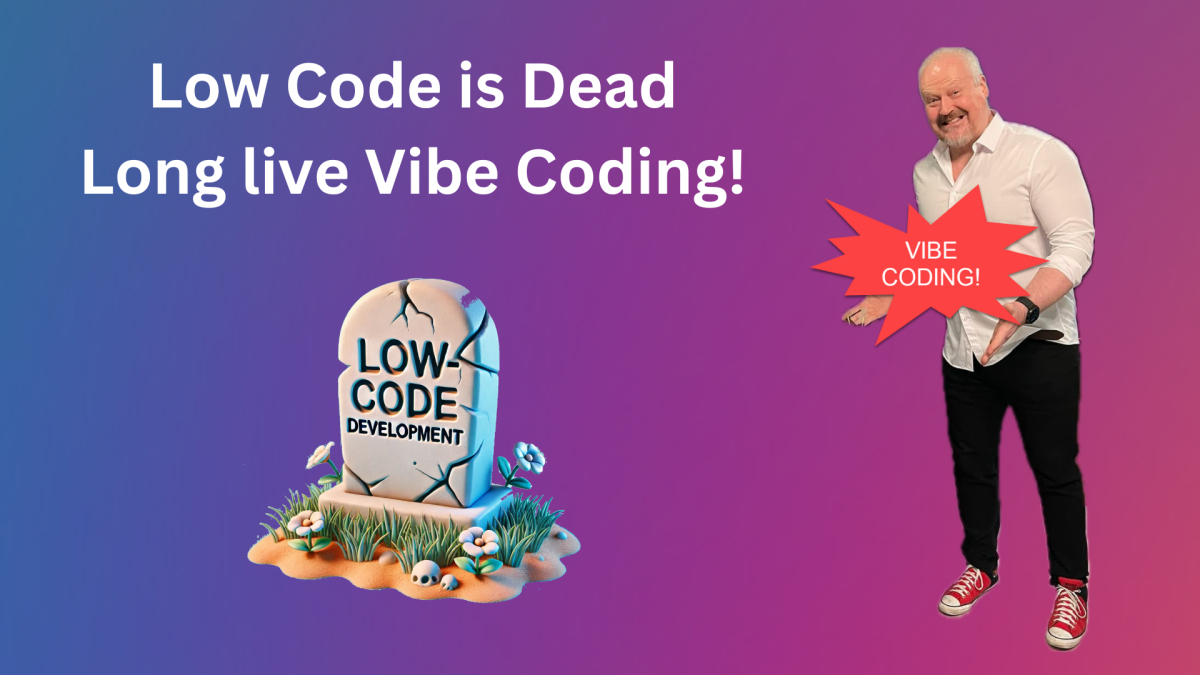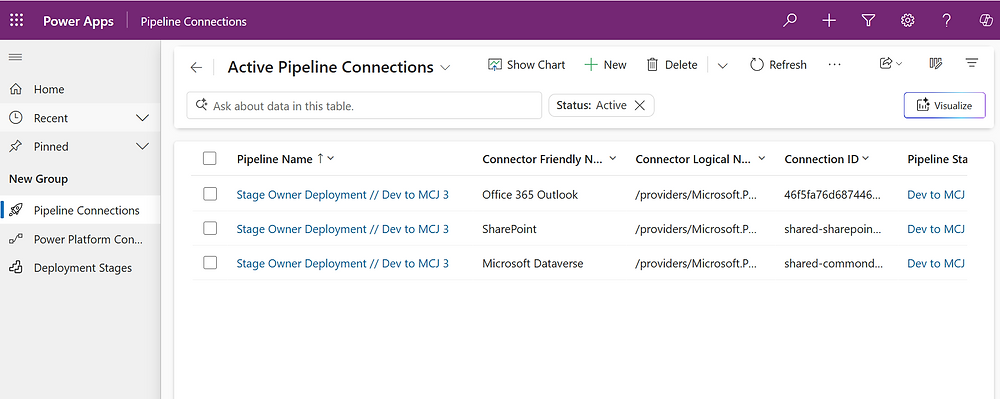Now Reading: Low-code is Dead. Long live Vibe Coding!
-
01
Low-code is Dead. Long live Vibe Coding!
Low-code is Dead. Long live Vibe Coding!

Thank you (and sorry) for indulging my click bait title. Also, the following is my own personal opinion, and in no way looking to offend or scare professional developers or low-code makers.
Here is the video version of this blog post:
There is a new buzzword term making the rounds that you may have heard of… Vibe Coding.
Vibe Coding – What is it?
Vibe coding is the latest technology or framework, it has been described as a software development mindset. Working with AI tools, as a developer you essentially describe (prompt) what you want to build and let your AI tool of choice do the coding for you.
We’ve all used tools like GitHub Copilot to generate or describe code. Vibe coding takes this a step further in a sense where you let the tool generate the code, run it, if it passes all your tests, great, if not, keep iterating until it does. Don’t understand the code? No problem, let AI explain what it does.
From a pro-code developer standpoint, this sounds like pure blasphemy. Maybe it is. I do love writing code, testing it out, seeing the results. I also liked driving my 2001 RSX Type S stick shift. Sadly I haven’t driven a stick shift in a couple of years. I am also not looking forward to giving up driving altogether, but, like it or not, this is where things are headed.
From a citizen developer, low-code, maker or whatever the name is these days… the question now is why would you use a low-code language or tools when you can have your cake and build pro-code solutions just a easy or even easier then using low-code? Its a very bold statement… and at the end of the day, even the low-code tools generate “pro code” in the background. Why not eliminate the middleware and all its constraints?
YouTube has a lot of examples of Vibe Coding where developers are building apps and games, not even looking at the code, letting AI do the actual coding and troubleshooting.
Vibe Coding in the Power Platform
We are beginning to see the concept of Vibe Coding to concept of the Power Platform as well. Check out this post by Chris Harper as he shows an excellent example of using Vibe Coding to integration Microsoft’s Azure AI Foundry to Dataverse using Python.
Example: Death to Business Rules! Vibe Coding to rescue!
Earlier this week I was working with some colleagues that were trying to define hiding and showing different fields on a model-driven Power App form based on selection of data. Following a “low-code first approach”, we looked at using business rules.
For anyone working with Dynamics CRM or model-driven Power Apps will likely at one time have used or considered using Business Rules. The idea of business rules is to provide an easy way for functional consultants, makers, or “citizen devs” to build simple, interactive logic. Business rules were designed in a way that almost anyone could setup and configure the logic through a simple (but now dated) user interface.

Business rules have limitations, so often the more tricky requirements can be resolved using client-side JavaScript.
In our case, we had a few slightly more complex requirements so decided to build the logic using JavaScript. Normally this kind of development would have taken me a couple of hours. Using a Vibe Coding mindset, it ended up only took me a few minutes!
The application we built is a lot more complicated. So let’s take a step back and consider a simple use case. For this example, I have built a very simple model-driven Power App that is used to track donations.

I have a requirement that if the donation amount is over $1000 I want to send a gift to the donor. I need to make sure that the donation gift selection is both visible and mandatory.
To stay with a low-code approach, I would use business rules.

Using the tool, I am able to configure the business rules. The process involves evaluating a condition, and based on the results, setting the field to visible and mandatory, or not. While intuitive, the tool required a number of clicks, selecting the apply button, and activating.

Once in place, the rules apply to the user running the app and work as expected. No code was written.

In this case, business rules are a good fit because the logic is simple. However, if you have used business rules for anything even slightly more complex, you will likely have run into issues. The other aspect is that the user interface is quite dated and Microsoft hasn’t seemed to make any investments in business rules. With AI, why would they?
In the application I was working on, we needed to pull data from related records and also make many other considerations. Using business rules got over complicated very quickly, and ultimately weren’t able to satisfy the requirement.
We opted to use client side JavaScript. JavaScript typically requires at least some pro-development skill. The requirement in question would have normally taken me a couple of hours to write, to test, and to re-iterate. As I was writing out the requirement as a DevOps task, I re-worded the requirement like a prompt, grabbed the affected table and column schema names and dumped them into ChatGPT. This not only generated working JavaScript code, but also an explanation of how the code worked.
Let’s try with our example above using the following prompt:
You are a Power Platform pro-developer, create JavaScript for a model-driven application that will show the rxrm_donationthankyou field when the rxrm_donationamount has a value greater than $1000 and also make the rxrm_donationthankyou mandatoryI entered the prompt and I also switched the model to use ChatGPT o3-mini-high as its more suited to coding.

Within a minute or so, not only do I have the code, but I have the explanation of how to implement it as well as how it works:

I then followed the steps outlined from the results and implemented the code:

I deactivated the business rule, and published, the code worked (I know, hard to tell from the screenshot) but it did. While I didn’t set a timer (maybe I will in the video version of this blog post), I would say it took me roughly the same amount of time or less than using the business rules editor.
In the end, I didn’t need to know JavaScript or even how it worked (I do). Would it be any different from the “code” that the Business Rules editor created in the background?

The benefit of the Vibe Coding method is that, like writing JavaScript code, we have a lot more options and flexibility. For more complex requirements, this process is a lot faster. For maintainability, I included the initial prompt in the code comments. Any future maker would be able to take the code and allow a copilot or any other AI tool to evaluate the code and provide information on how it works or suggest improvements to resolve a bug or the enhance.
In my example, I cut and paste the code, but as tools evolve, this could become more integrated. With the introduction of MCP (Model Context Protocol) these systems can become more integrated, allow traditional “makers” to easily create, test, and deploy professional code and build full applications.
The end of low-code?
If citizen devs, makers, functional consultants, and even business users can easily access these tools, would we even need low-code tools? Why build a canvas app or a Power Pages website if we can just as easily build native apps and websites?
There are a lot of reasons, things like security, authentication, governance, etc. are built-into the platform and easily configurable. There is no need to re-invent the wheel, AI generated or otherwise.
I feel the Vibe Coding concept will incorporate itself into these tools. We see things like Plan Designer and other Copilots evolving and getting more traction. In a years time, I think we’ll still have “canvas” apps, but they may be much more closer to a pro-code layer behind the scenes.
And we will still need humans to dream up the apps, consider the logic, the user interfaces, experiences. The game is the same, but the tools have changed.
And I hope to someday again have a stick shift car!
Now that you have this new superpower of Vibe Coding… what will you build?
Nick Doelman is a Microsoft MVP, podcaster, trainer, public speaker, and competitive Powerlifter. Follow Nick on X at @readyxrm or LinkedIN, and Bluesky. Listen or watch the the Power Platform Boost podcast with Nick and co-host Ulrikke Akerbæk every second week for news and updates from the Power Platform community.
Original Post https://readyxrm.blog/2025/04/10/low-code-is-dead-long-live-vibe-coding/















